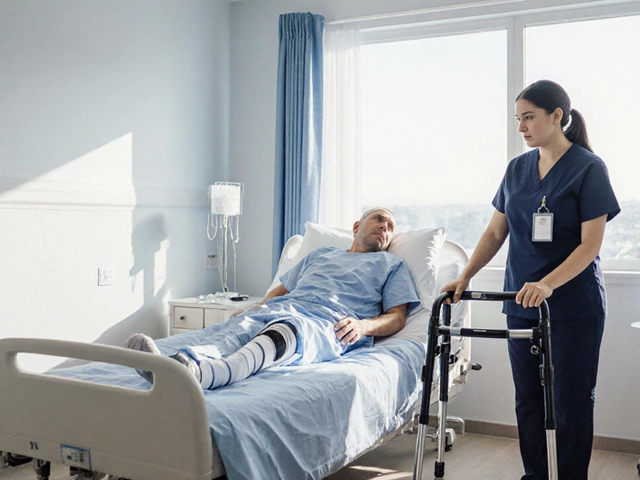
You've just gone through the grand adventure of knee replacement, huh? Now, you're probably dealing with a stiff knee, and that can really be a bummer. But don't worry; it's super common. While a new knee can mean a renewed active life, that stiffness is trying to hold you back. But you've got this! Ready to get that knee moving? Let's talk about some easy tactics.
First up, movement is your new best friend. Think of your knee as a lazy roommate that needs a nudge to get going. Gentle exercises can open up a world of flexibility, making everyday tasks easier. Start with some simple stretching or even walking around the house—yep, even that counts!
But hey, knowing when to take it easy is crucial too. If your knee's yelling at you, it might be time for a break. Balancing exercise with rest is key. Too much of one, not enough of the other, and your knee won't be happy.
- Understanding Knee Stiffness After Surgery
- The Importance of Movement
- Gentle Exercises to Improve Flexibility
- When to Rest and When to Push
- Using Heat and Cold Therapy
- When to Seek Professional Help
Understanding Knee Stiffness After Surgery
So, let's talk about why a stiff knee happens after you've swapped out the old joint. Right after knee replacement surgery, tissue gets a bit grumpy from all the cutting and stitching. This can lead to swelling and stiffness, making it hard to get moving initially.
The body's natural reaction to surgery is inflammation, kind of like when you stub your toe but on a bigger scale. This inflammation can cause the surrounding muscles and ligaments to tighten up, almost as if they're scared of being moved. Weird, right?
Another thing to consider is the formation of scar tissue. As your knee heals, scar tissue develops, and while it's a sign of healing, too much can tighten the joint further. It’s like overdoing it with the wrapping paper on a gift—it just makes things tougher to open.
Age, fitness level, and your personal health habits play a role too. Younger, more active individuals might notice stiffness easing up faster, thanks to better muscle tone and circulation. Older folks or those with additional health concerns might have a longer recovery phase.
Recognizing the Signs
How can you tell if the stiffness is more than the usual post-op experience? Common indicators include difficulty bending or straightening the knee fully, pain when moving or even at rest, and the feeling that your new joint isn’t quite clicking yet.
| Average Recovery Timeline | Stiffness Resolution |
|---|---|
| First 2 Weeks | Lots of rest, ice, and early mobility work |
| Weeks 3 to 6 | Increasing strength and movement exercises |
| After 6 Weeks | Steady improvements, with intermittent stiffness |
If your experience with stiffness falls outside this usual path, it's a good idea to loop in your doctor. Timely intervention can prevent long-term mobility issues.
The Importance of Movement
Getting back on your feet after knee replacement surgery isn't just about the surgery itself; it's about the move towards recovery. Why is movement so vital for a stiff knee? Well, think of it as oiling a rusty machine. Without movement, everything just tightens up a little too much.
Why You Gotta Move
Your knee is designed to move, and after surgery, it's even more crucial to keep it active. Movement improves circulation, which can reduce swelling and pain. More importantly, it prevents scar tissue from building up in ways that limit your range of motion. Regular activity helps your knee regain its flexibility and strength faster.
Easy Ways to Start Moving
- Walking: Try short walks around your home a few times a day. It doesn't have to be a marathon, just enough to keep things from locking up.
- Leg Raises: While you're lying in bed or on a couch, consider straight leg raises. This helps strengthen your knee without much stress.
- Knee Bends: These can be done while sitting, giving your knee a gentle workout without the pressure of standing.
Remember, consistency is key. Seeing improvements is a gradual process, so keep at it.
Benefits Backed by Data
Moving isn't just a hunch. According to the research, patients who engage in regular, gentle exercises recover function significantly faster than those who remain inactive. The numbers are clear: with regular movement, people report up to 50% less stiffness and quicker recovery times in just a few weeks.
Listening to Your Body
Movement is important, but so is listening to your body. If something feels too painful, it's okay to take a step back and reassess. Progress isn't always linear, and taking small steps forward is better than none. Don't beat yourself up if you have days when your knee just doesn't want to cooperate.
So there you have it. A little movement every day can make a world of difference for your knee replacement recovery. You are literally doing the legwork to a more flexible life.
Gentle Exercises to Improve Flexibility
Alright, so you're dealing with a stiff knee after your knee replacement. No worries—some simple exercises can really help to grease up those knee joints and bring back flexibility. Here's how you can get started without overdoing it.
Heel Slides
Let's start with heel slides. This one's great for maintaining range of motion. You're basically in the driver's seat here. Lie down on your back, keep one leg flat and comfortably slide the heel of the affected leg towards your rear as far as you can. Hold for about 5 seconds and then slide it back. Do this 10-15 times per session. Remember, take it easy and listen to your body.
Seated Knee Bends
Next, seated knee bends will do wonders. Find a comfy chair, sit straight, and slowly bend your knee back as far as you're able to, then straighten it out. Easy, right? Aim for 2 sets of 10 repetitions.
Ankle Pumps
Don't forget the ankle pumps! They might seem trivial, but they keep the blood flowing and help reduce swelling. Simply flex and point your foot back and forth 10-20 times. This exercise can be done sitting or lying down.
Chair Squats
Once you're feeling a bit braver, chair squats can help build strength gradually. Stand up from a seated position using your leg muscles, not your hands, and hover above the chair for a moment before sitting back down. Again, 10 reps can make a notable difference.
Standing Heel Raises
Stand on your toes and hold it for a few seconds. Think of it as ballerina practice, but just for balance. You'll strengthen your calf muscles in the process. Repeat 10 times, and give your calves a gentle massage afterward to ease any tension.
| Exercise | Number of Repetitions |
|---|---|
| Heel Slides | 10-15 per session |
| Seated Knee Bends | 2 sets of 10 |
| Ankle Pumps | 10-20 |
| Chair Squats | 10 reps |
| Standing Heel Raises | 10 times |
Just remember to listen to your body and go at your own pace. The keyword is 'gentle,' so don't push through pain. Feel good by moving more, but don't forget to savor those rest breaks too!

When to Rest and When to Push
Okay, balancing rest with effort after a knee replacement is a bit like mastering a seesaw. You don’t want one side crashing down while the other hangs in the air. How do you know when to rest and when to push?
Listen to Your Body
Your body’s got its own language, especially after surgery. Feeling a dull pain is often okay, but if it turns sharp or unbearable, that’s your knee screaming for a rest. It's like your dog Charlie barking like crazy when he wants out. Pay attention, because ignoring this will only backfire.
Set a mood of careful progression. Don’t expect to run a marathon tomorrow. Celebrate small wins and note any improvements.
Work with Your Physiotherapist
Got a physio? They're like your personal knee whisperer. They'll set guidelines for activities that help—and ones that might cause trouble. Respect their expertise the way you'd trust a chef in the kitchen. They know the right amounts of pushing and resting.
- Stiff knee not improving despite hard work? It may be time for a reassessment by them.
- Following their prescribed exercises can maximize gains without overtaxing your knee.
A Typical Day Post-Surgery
Here’s a nifty little schedule to consider:
- Morning gentle stretches and short walks.
- Midday focused exercises and activity—but stop if your knee feels too stiff or sore.
- Afternoon rest with some icing to reduce any swelling.
Quick reminder: the urge to rely back on pain meds may arise, but use them wisely and only as needed. Confidence and knowing your limits will help you progress safely. Your newly replaced joint will thank you.
Using Heat and Cold Therapy
Let's get into one of the best tricks in the book for handling that stiff knee: heat and cold therapy. It sounds fancy, but it's a super straightforward method. Think of it as playing a hot-and-cold game with your knee! It's amazing at reducing swelling and easing pain, which is exactly what you need after a knee replacement.
Why Heat and Cold?
Heat is like a warm hug for your knee, boosting blood flow and relaxing those tight muscles. Cold is the ice pack that swoops in to reduce swelling and numb that darn pain. Together, they make a power couple you can't ignore. But knowing when to use which is important.
When to Use Heat
Heat is perfect for loosening up your stiff knee. Use it when you're feeling tight or about to exercise. A warm towel or heating pad can do wonders for 15-20 minutes. Just don't burn yourself—it's not worth it!
When to Reach for Cold
Got swelling or extra pain after movement? Cold therapy is your go-to. Ice packs or a bag of frozen peas can calm your knee down in no time. Keep it on for about 10-15 minutes, but never let the ice touch your skin directly.
Handy Routine
- After Exercise: Start with cold to tackle any post-workout swelling.
- Before Exercise: Use heat to warm up your knee and get it ready.
- In-Between Times: Balance between heat and cold, and listen to what your knee needs.
It's also worth knowing that studies suggest alternating between heat and cold could sometimes work even better. It's like your knee gets the best of both worlds!
When to Seek Professional Help
After a knee replacement, knowing when it's time to call in the pros can make a big difference in your recovery. So, what are the signposts that tell you it's time to see a doctor?
Persistent Pain
If the pain in your knee isn't letting up despite regular exercises and rest, or it suddenly spikes, that's a good time to reach out for help. A bit of discomfort is normal, but if it's not improving, a professional's insight could help figure out what's going on.
Limited Mobility
Has your stiff knee wreaked havoc on your daily routine? If tying shoelaces or getting out of a chair feels like scaling Mount Everest, it’s time to chat with your healthcare provider. They can recommend therapies or assessments to pinpoint and fix the issue.
Swelling or Redness
Notice your knee puffing up or looking red and angry? Swelling could mean an infection or inflammation. Catching it early with medical help can prevent bigger problems. Better to be safe and get it checked out!
Fever
A fever might not seem related, but if it's cropping up after surgery alongside knee trouble, it should set off some alarm bells. It might indicate an infection that needs addressing.
Your Health Check-in List
- Unresolved pain
- Progressing stiffness without improvement
- Signs of infection like fever and redness
With these signs in mind, you're not alone or stuck. There's a whole team of professionals ready to get your knee back in shape. Don't hesitate to reach out!
Categories
Popular Articles


Apr 12 2025

Mar 17 2025




